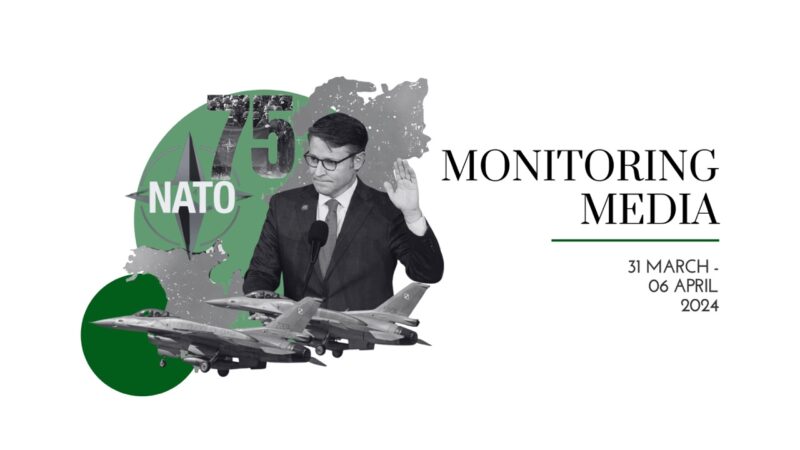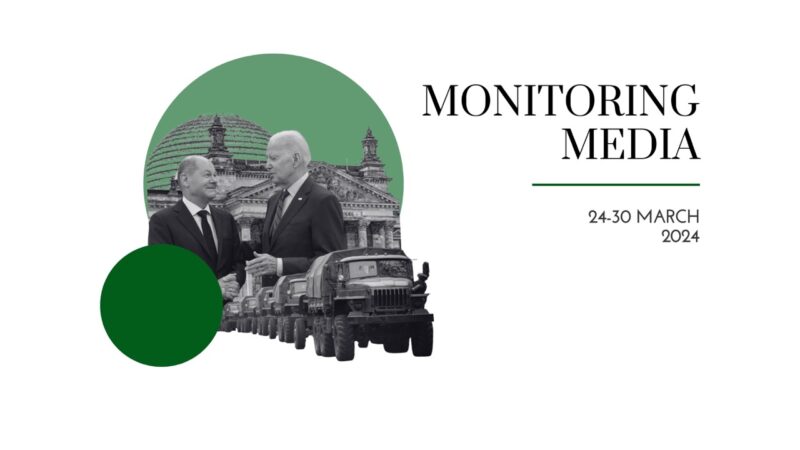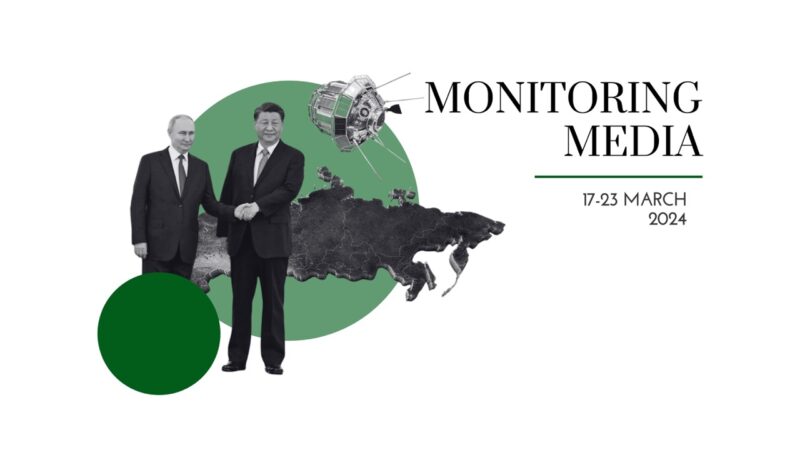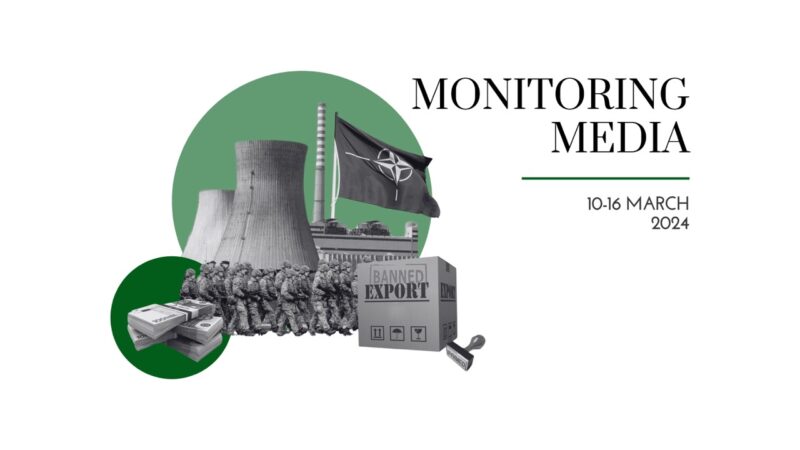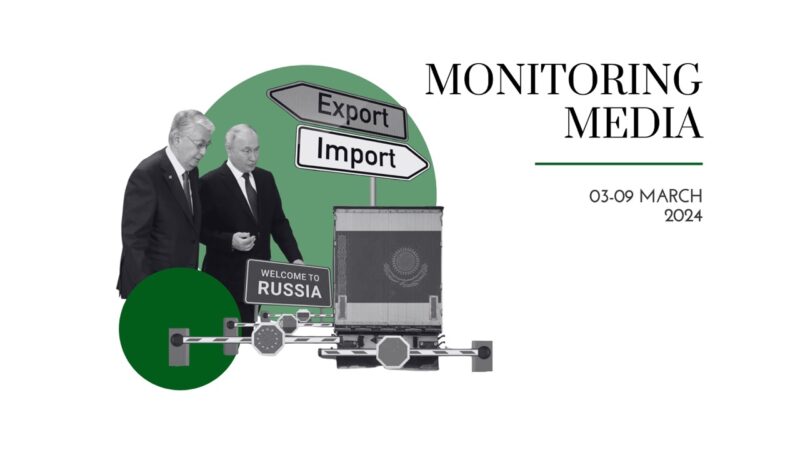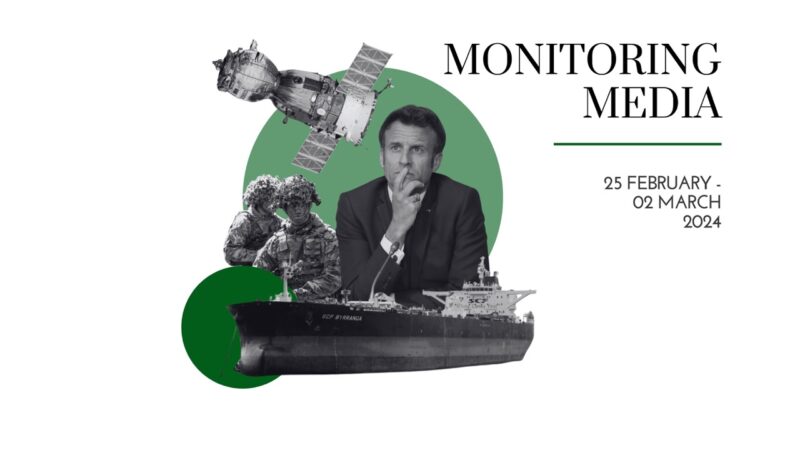Western security depends directly on the quality of weapons given to Ukraine

CIUS weekly report on media coverage of Ukrainian affairs, 12–18 November 2022
Three publications (The Atlantic, The Economist, and The National Interest) were selected to prepare this report on how the situation in Ukraine has been portrayed in the press during the past week (12–18 November 2022). The sample was compiled based on their impact on public opinion as well as on their professional reputation, popularity among the readership, and topical relevance. These three publications represent centrist, liberal, and conservative viewpoints on the political spectrum.
This report covers only the most-read and relevant articles about Ukraine, as ranked by the respective publications themselves in the past week. Its scope covers promoted articles on home pages and articles from special sections on Ukraine, with the hashtag #Ukraine, from the paper editions of the publications, and about Ukraine from opinion columns and editorials.
Topics featured in the selected articles:
- Ukraine’s current affairs: The de-occupation of Kherson lifted spirits among Ukrainians, but restoration of the destroyed infrastructure will take years; Ukraine has yet to decide how to strategically benefit from its victory in Kherson; mobile bomb shelters being built in Ukraine’s major cities;
- The world and Ukraine: The missile attack on Poland should encourage the West to supply Ukraine with better anti-air weapons; Western anti-nuclear defensive technology might provoke Putin to test it with a nuclear strike; Western Europe and Russia are the two actors most interested in negotiating peace; the biggest developing states could serve as mediators in future peace talks between Ukraine and Russia;
- Russia at war: Russia has become a terrorist state that orchestrated the missile strike in Poland; Russia’s nuclear blackmail is a more effective tool in warfare than the actual deployment of nuclear missiles; for Russia to become a “normal” state, its society and elites must rid themselves of the imperialist mindset.
The most common arguments:
Ukraine’s government will face challenges in bringing life in Kherson back to normality any time soon. The Economist offers reportage from the central square of Kherson after its liberation and narrates the life stories of many people who survived the Russian occupation and celebrated their return to Ukraine. The history of Kherson under the short-lived Russian rule sounds stressful in the people’s stories: the occupiers wiretapped phone talks, kidnapped social activists, put pressure on businesses, and conducted regular inspections at checkpoints. “The Russians tried to impose Russian television, the rouble, and a Russian curriculum in schools and held a sham referendum supporting the annexation of Kherson—announced by the Kremlin in any case on September 30th. None of it was very effective.” According to data from President Zelensky, who visited Kherson almost immediately after its liberation, more than 400 war crimes in the city and its outskirts have been recorded. Moreover, before the Russians left they boobytrapped administrative buildings, looted closed shops, severed electric grids, “toppled the television tower, and destroyed phone masts.” Meanwhile, local collaborators retreated alongside the retreating occupiers—they were afraid to face the anger of Khersonians. The city that the Ukrainian army re-entered was plagued with a lack of heating, light, water, and communication. Today, Khersonians are happy to be back in Ukraine, and they sound confident that they could strive through the harsh living conditions of the coming winter. However, the return of Kherson to normality and restoration of utilities may be easier promised than done in a front-line city in times of war.
The future of Ukraine’s counteroffensive remains difficult to predict. The Economist praises Ukraine’s successes in the liberation of Kherson city but also highlights that 70 per cent of Kherson oblast remains under Russian control and the front lines have not yet been stabilized. The Economist argues that the world is yet to see “whether Kherson represents the last gasp of Ukraine’s spectacular offensives or, as Mr Zelensky suggests, just another milestone in the steady collapse of Russian lines.” In an attempt to address this issue, the Economist draws three possible scenarios for future events. The first scenario assumes that the Ukrainian army will swiftly traverse the two-kilometre-wide Dnipro river in the Kherson oblast and continue the pursuit of withdrawing Russians. The second scenario argues that Ukraine will shift its counteroffensive to the eastern Luhansk oblast where the morale of the Russian army is very low. The third and most ambitious scenario resides in Ukraine’s breaking Russian lines in Zaporizhia oblast and advancing toward Crimea from the north. The Russian command seems to be aware of all three scenarios and reinforce their defences. That being said, the Russians are running out of artillery ammunition and ballistic missiles which restrains manoeuvres they can perform. The Economist cites military analysts who either believe that the Ukrainian counteroffensive will stall during the winter and lose its momentum in 2023 or that Ukrainians will speed up liberating their territory, given an adequate arms supply.
Ukraine working to increase the number and availability of its civilian bomb shelters. The Economist writes that to protect civilians in Ukraine’s cities from Russia’s air attacks, local administrations decided to install mobile bomb shelters made of concrete. One of the cities pioneering the project is Dnipro, where they plan to deploy 28 combat-tested shelters. The administration believes that the concrete walls “won’t withstand a direct hit…but they will protect against blast waves, shrapnel and flying glass.” The Economist writes that since the 1940s over 300 shelters have been built in Dnipro, some of which allow survival of a nuclear blast. The local subway system has also been converted into a shelter and is actively used today for hiding as well as artistic performances. The Economist concludes that Ukraine has embarked on a shelter boom: “schools and businesses all over Ukraine are building new and larger shelters. Hospitals have been busily renovating their basements. Construction companies are advertising dual-purpose cellars, lined in reinforced concrete or 4mm-thick steel plates, that can be used for saunas, storing wine or sheltering from bombs.” This shelter boom serves as a worrying indicator that the war is going to continue for some time.
The West needs to take even bolder steps in order to support Ukraine’s war effort. The Economist highlights that the missile which hit Polish ground on 15 November and killed two people was a Ukrainian interceptor, launched to counter Russia’s aerial assault. In other words, Poland would have never suffered harm if Russia did not target Ukraine with its missiles. The Economist deduces that “Russia is escalating because it is losing. The West must keep its cool and intensify its support for Ukraine. This is a time for bold steps.” The bold steps, according to the Economist, should entail in providing new packages of emergency aid to Ukraine (especially money from the EU), dispatch of tanks (such as German Leopards), and fighter jet planes (such as Swedish Gripens). Instead, the statements of caution voiced by war-sceptics, such as of the US General Mark Milley, “cast doubt on Ukraine’s ability to shift the front lines farther” and suggest that the government in Kyiv “should consider negotiations with the Kremlin.” The Economist finds such statements flawed as they will only win time for Russia to re-arm and recruit more soldiers while stalling Ukraine’s successful stall.
Western progress in missile-defence technologies may aggravate the Kremlin. In light of many uncertainties surrounding the Russo-Ukrainian war—for instance, the question of origin of the missile that hit Polish territory last week—Kelsey D. Atherton (The Atlantic) argues that “there are reasons to believe that the Kremlin might use…Russia’s world’s largest nuclear arsenal” at a certain point. Paradoxically, the current development of defensive technologies to mitigate the risk of a nuclear strike makes the mentioned risk even higher: “Nuclear arsenals create a shared sense of vulnerability among the leaders of nuclear-armed nations. But the development of missile-defense technologies unbalances the equation.” First, by acquiring effective air defence systems, the benefiting nation gains more confidence to deploy its nuclear missiles against others. Secondly, having to break through a dense line of air defence systems, the attacking nation may decide to launch more nuclear missiles. Third, being caught in an arms race, the burdened nation may decide to launch its nuclear missiles before the air defence systems of the opponent become fully operational. In this light, the more the US develops its defensive capacities and the more weaponry is shipped to Ukraine, the higher anxiety ratchets in the Kremlin. In his article, Atherton provides insight into existing philosophies of nuclear deterrence and lists technological breakthroughs that led to changes in these philosophies in the past. Atherton ends by stating that “the prospect of abrupt and sudden destruction, through mistake or panic or anger, hangs over us at all times, so long as the weapons and the means to use them exist. The risks can be mitigated through careful stewardship and calm handling of crises, but it can never be fully removed, nor can it be engineered around.”
The parties most interested in negotiating an armistice are the West and Russia. Lasha Tchantouridze (The National Interest) argues that following the liberation of Kherson, “freezing the war in Ukraine might benefit Russia and the West, but it will not solve the problems this war has generated between Russia and Ukraine, and Russia and the West.” Tchantouridze scrutinizes the interests of the three stakeholders—the West, Russia, and Ukraine—to point out that it is only the latter and some of the Central European states that are strongly opposed to an armistice. If active fighting stopped today, the Kremlin would be able to communicate “victory” to its citizens, restore connections with its former European partners, solidify its governance over the occupied Ukrainian territories, secure a land bridge to Crimea, and rebuild its army for a new invasion of Ukraine. Meanwhile the West, so the thinking goes, would be able to restore its energy supplies, cut expenses on supporting Ukraine’s war effort, and end the era of Russia’s nuclear blackmail. For its part, Ukraine would have to stop its so-far successful counteroffensive, agree that its southern and eastern territories will not be “de-occupied” any time soon, maintain its army constantly battle-ready, and possibly lose Western support in the long run (especially if a more Russia-favourable leader wins the US presidential elections in 2024). At this moment, as Tchantouridze argues, there remain too many unknown factors to predict the developments in the Russo-Ukrainian war. The only certain thing is that the fighting during wintertime will slow down, yet it will continue to put a strain on all the engaged sides—a strain that all of them would like to relieve as soon as possible.
Brazil, Saudi Arabia, and India could help broker peace between Ukraine and Russia. Edward Salo (The National Interest) ponders that “the Russo-Ukrainian War presents an opportunity for another emerging power to establish itself in the international arena by serving as the mediator of a peace conference.” Salo compares the existing situation to the one a century ago, when Japan was waging war against Russia (1904–05) and the US stepped up to relieve the tension. The US initiative and successful performance helped it to secure its interests in Asia and gain more prestige in the eyes of the international community. Salo argues that the Russo-Japanese war shares many similarities with the Russo-Ukrainian war. In particular, Russian losses in people, armoured vehicles, and navy vessels against a supposedly weak opponent are dramatic in both cases. Also, the superiority in advanced technologies allows the asymmetric responses of smaller states to be very effective against the Russian military machine. Salo tries to assess the contemporary geopolitical situation and suggests that Brazil, Saudi Arabia, and India could perform the same role in brokering peace today as the US did a century ago. These nations are identified because they “have the diplomatic and military power, as the United States had in 1905, [and qualify] as a near-peer to Russia but not a threat to Russia’s existence. Furthermore, [these nations do not] have a direct interest in the region (i.e., Turkey) but have some economic interests at stake (e.g., Ukrainian food production).” Salo concludes, however, that even if the mentioned nations attempt “to broker a peace agreement, that does not guarantee it would be accepted or that Russia would abide by the terms in the long run.” The war goes on, and both Ukraine and Russia continue to press for their vital objectives regardless of the losses or the forthcoming challenges of winter battles.
Russia is a terrorist state that orchestrated the missile strike in Poland. Anne Applebaum (The Atlantic) argues that the investigation of which side launched the missile and hit the Polish village of Przewodów is of secondary importance, because “the real cause of this explosion and the deaths of two people is the Russian invasion of Ukraine, an invasion that has already devolved into an advanced form of state terrorism.” As a rule, terrorism is practised by small groups of political marginals who use violence to promote their agendas. However, contemporary Russia, “like ISIS or the IRA, seeks to inflict suffering on Ukrainian civilians” because it failed to defeat the Ukrainian army and complete its territorial conquest. The strike inflicted on Poland resembles thousands of others that Ukraine has endured for nine months already. The only major difference is the fact that Poland remains protected by NATO’s “Article 5” security guarantee (which, we note, Polish officials did not rush to invoke). Applebaum ponders that “the Przewodów incident might not be the one that brings NATO more directly into this conflict. But it should serve as a reminder [that] the Russian regime remains extremely dangerous…to Poles, Balts, and indeed Germans and other Europeans whose cities are also well within the range of the cruise missiles being fired across Ukraine.” To address the issue, Applebaum recommends providing Ukraine with more modern tanks, ammunition, and air defence systems so that the Russian army loses its advancing potential and withdraws as soon as possible.
Russia would gain fewer benefits from a nuclear strike in Ukraine compared to the benefits of strategic nuclear blackmail. Gregory Mitrovich (The National Interest) argues that the Kremlin has not yet used its ultimate weapon in Ukraine’s theatres because “the deterrent value of Russia’s nuclear arsenal remains greater than its possible benefit on the battlefield.” With his legacy in ruins, his army in disarray, and his country in upheaval because of the disastrous recent mobilization, resorting to the nuclear option would seem to be a reasonable move for Putin. Not to mention that he threatened numerous times to do so. However, Putin’s reluctance to go nuclear may be explained by the same challenges that the US experienced during the first year of the Korean War. With the Southern Korean army in retreat and the US forces facing the risk of “Dunkirk 2.0,” the Truman administration considered atomic bombings. However, the fear was that “an ineffective nuclear attack in Korea would badly degrade America’s strategic position around the world…[If] nuclear weapons failed to stop the Chinese advance, [that would] potentially undermine deterrence in Europe, as nuclear weapons were vital to any hopes of stopping a Soviet invasion.” If Putin authorized the deployment of a nuclear weapon in Ukraine, he would probably gain little strategic benefit, due to the absence of clear targets for a powerful strike as well as the very long front line. At the same time, the deployment would lead to radioactive contamination of Russia and Eastern Europe, global outrage at the Kremlin’s actions, and discreditation of Russia’s military prowess. Moreover, such a move would likely encourage a combined armed response between NATO airpower and the Ukrainian army to halt the Russian invasion. Mitrovich concludes that “nuclear use would vastly magnify Russia’s crisis by turning what few allies it has against it.”
Russia will become less domestically and internationally violent if its imperial mindset gets compromised. Anne Applebaum (The Atlantic) uses the example of the (short-lived) Moscow-based School of Civic Education to illustrate the challenges of fostering a truly new generation of political elites in Russia. The school offered all interested Russians a discussion on a variety of nation-building and transformational topics—for instance, on effective federalism and local governance. It functioned for almost thirty years and was shut down in 2021 after the state designated it a “foreign agent.” Using this example, Applebaum delivers the message that in Russia, those who start questioning authoritarian ways of governance that are closely connected with an imperialist mindset almost immediately become dissidents. Applebaum also asserts that many contemporary Russian liberals or Putin-sceptic politicians cannot be called genuine dissidents, because they support imperial claims: “many Ukrainians consider the Russian democratic opposition just as culpable, just as imperialist, and just as responsible for the war as non-dissidents.” For their part, ordinary Russian citizens often avoid criticizing the war or protesting against the Kremlin’s aggression in the international arena, but—whether for ideological reasons or mere self-preservation—they do not wish to engage in the war effort or be deployed to the battlefield (this is the reason thousands of Russians quietly left their state as just the mobilization was announced). That being said, Applebaum argues that forces do exist that criticize the imperial essence of Russian governance (i.e., the core of the problem that leads to authoritarianism) and advocate for regime change to a nation-state. They should be differentiated from Russian “liberals.” Applebaum concludes that “Russia’s future will be shaped by how its leaders and citizens interpret the tragedy of this shocking, brutal, unnecessary war.” Defeat in the war may send a powerful wave across Russian society and sweep out its imperialist sentiments.
